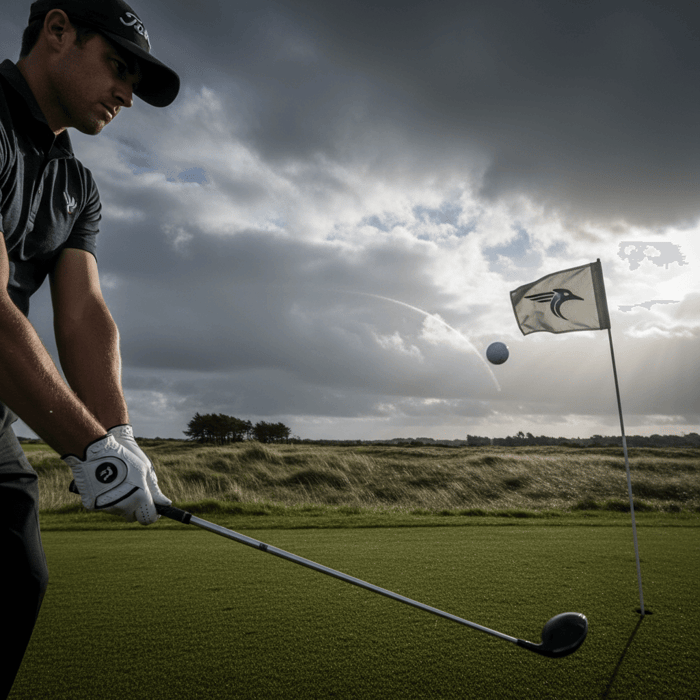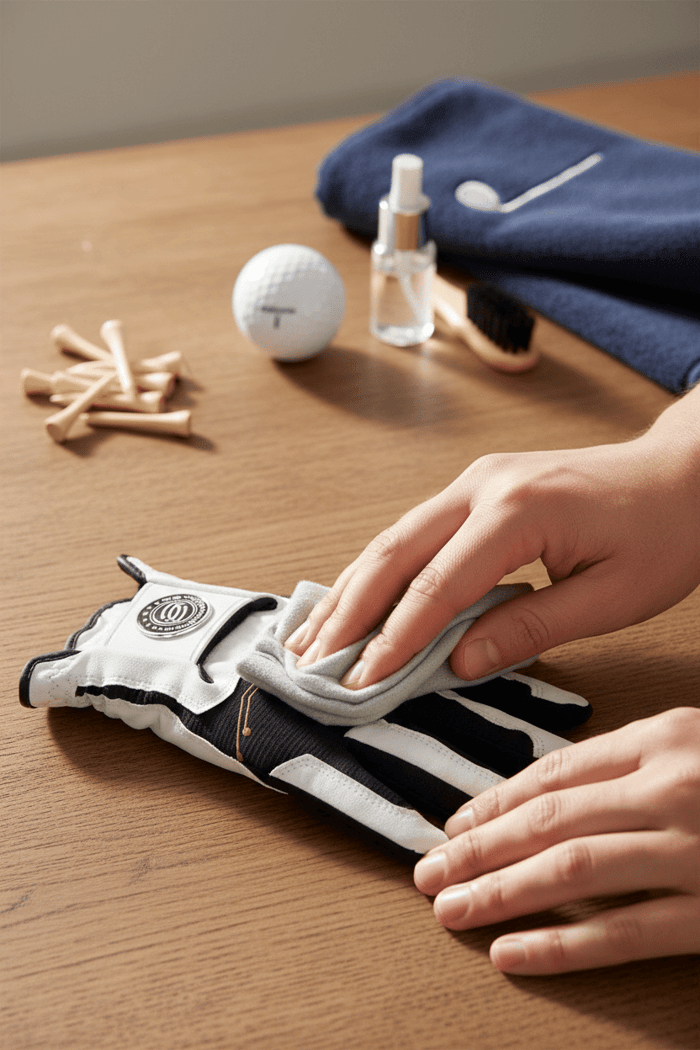Table of Contents
That crisp fall morning felt great until your first drive came up 30 yards short and your hands started to sting. Every 10-degree drop in temperature can cost you 2–3 yards of carry distance, but the real score killer isn't just the cold air. It's the lost control you get from a stiff grip. If you aren't adjusting your game and your gear, you aren't just losing distance; you're leaving strokes on the course.
The truth about how weather affects your golf game is that it’s never just one thing. It's a complicated chain reaction that hits the ball, the course, and, most importantly, your body’s connection to the club.
As golfers who play year-round, we’ve broken down the science and consulted the experts to show you how a strategic equipment change—the right golf glove—can turn terrible weather from a frustration into a competitive advantage.
The Hard Facts: What Happens to the Ball and the Air
When you start digging into how weather affects your golf game, the first thing everyone talks about is the ball. It’s simple physics, after all. The atmosphere and temperature directly mess with the flight and compression.
Temperature: Why Cold Air and Cold Balls Make You Shorter
Cold air is much denser than warm air. That's the basic science that matters here.
Air Density and Drag: When the air is thick, it creates more drag on the golf ball. Your shot is fighting a heavier barrier, slowing the ball down faster and reducing your carry distance.
Ball Compression: A cold golf ball gets harder, especially those with a softer cover. It doesn't compress well against the clubface at impact, which means you get poor energy transfer. This "cold compression" is a big reason why you feel that distance drop-off on a chilly day.
Lots of golfers try to fix this by swinging harder, but all that does is mess up your tempo and accuracy. The real fix starts with understanding your body’s response.
Rain, Dew, and Humidity: The Silent Swing Killers
Water, whether it's pouring rain or just heavy morning dew, is the quickest way to ruin your short game control. Sure, a wet clubface creates unpredictable spin, but the biggest problem happens right in your hands.
A wet grip makes the club slick, forcing your brain to overcompensate by squeezing harder—that infamous "death grip." That involuntary tightening strains your forearms, reduces fluidity, and can actually cost you up to 5 mph in clubhead speed. You tighten up to hold on, and you end up swinging slower and hitting shorter.
Humidity is another subtle factor. Humid air is actually less dense than dry air at the same temperature. Water vapor is lighter than the nitrogen and oxygen it displaces. So, on a really humid day, the ball faces slightly less resistance, which can mean a little extra carry distance. Knowing this helps you dial in your numbers on certain days.
Wind: Your Constant Adversary
Wind is usually the toughest factor to deal with because you can’t see it clearly. It affects the ball's flight using the Magnus Effect, which is the force created when backspin interacts with airflow.
Headwind: This greatly shortens your distance. You’ll need to club up and hit a lower shot to keep the ball out of the thick air.
Tailwind: This adds distance but makes the ball harder to stop on the green because it reduces the effect of backspin.
Crosswind: This one’s the most challenging. It exaggerates any side spin you put on the ball. If you have a slight slice or hook, the wind will turn it into a disaster. You have to aim significantly into the breeze to compensate.
The Human Factor: Stiffness, Focus, and Feel
The elements don't just affect the ball; they mess with a golfer’s ability to execute. To make a confident swing, you need two things: feel and flexibility. Cold weather degrades both.
The Problem of Stiff Hands and Lost Feel
When you play in the cold, your body is smart—it focuses on protecting your core, which means it cuts back blood flow to your fingers and hands. That reduced circulation makes you lose dexterity and causes stiffness.
Lost Feel: Your hands need to be nimble and responsive to release the clubface correctly. When your hands stiffen up, that precise control vanishes. You simply can’t strike the ball consistently.
Grip Instability: Even if the club isn’t wet, cold skin and stiff knuckles prevent you from making the light, stable connection you need with the grip.
The Mental Game: Adjusting Your Expectations
A huge part of how weather affects your golf game is how you handle it mentally. It's frustrating when your solid 7-iron shot comes up short or a headwind turns your drive into a pop-up.
Successful golfers adopt a simple rule: Accept the challenge. They lower their expectations for distance and focus only on course management, maintaining tempo, and hitting the center of the clubface. Fighting the conditions is always a losing battle.
The Better Way: How the Right Glove Keeps You in Control
This is the point where we transition from problem to solution. You’ve tried extra towels, changing out cheap leather gloves, and maybe even some grip powder. The issue is that most standard gear is built for one thing: a perfect 75-degree day. To actually beat the elements, you need gear that changes with the weather.
The Copper Tech Golf Glove was designed to solve the toughest problems caused by cold, damp, and humid conditions.
Grip Consistency: Maintaining Control in All Conditions
Traditional leather gloves are great when it’s dry, but they get slippery and rigid the moment they get wet. They rely on the absence of moisture. Copper Tech gloves are built differently.
The glove uses advanced synthetic microfiber material that offers exceptional grip in all conditions. Unlike leather, this material is engineered to actually grip better as it gets damp or wet, giving you superior control when you’re playing golf in the rain or thick morning dew. That non-slip grip lets you keep the light, low-pressure hold you need for maximum swing speed and feel.
Moisture Management and Feel
Whether it’s a sweaty summer palm or a damp fall morning, moisture kills your grip. The material in the Copper Tech glove is incredibly effective at wicking moisture away.
The glove actively pulls moisture off your skin, preventing slippage and keeping your hand dry and secure on the club. That means you won’t have to rotate gloves every few holes just because your hand is sweaty or damp. This level of reliable performance ensures a consistent connection for the entire round.
The copper-infused fabric technology also helps with thermal regulation, keeping your hands warmer and more flexible without adding bulk. You get the warmth you need for cold weather golf without losing the delicate feel that’s necessary for those crucial shots around the green.
Your Transformation: Play Confidently, No Matter the Forecast
You’ve learned that consistent golf in variable weather isn't about power; it’s about preparation, strategy, and having the right gear.
By understanding the physics of air density and precipitation, dealing with the problem of stiff hands, and wearing a glove that actively supports your grip and feel, you immediately gain an edge over the average golfer. You stop fighting the weather and start using proper preparation to your competitive advantage.
The shift from being a frustrated, weather-impacted golfer to one who thrives in all seasons is simple when you have the right gear. See why thousands of golfers trust the engineered grip, comfort, and consistent performance of a glove built for all conditions.
Ready to stop letting the weather control your score?
Explore the Copper Tech Golf Glove and experience the difference superior all-weather grip makes on your game.


.jpg)


